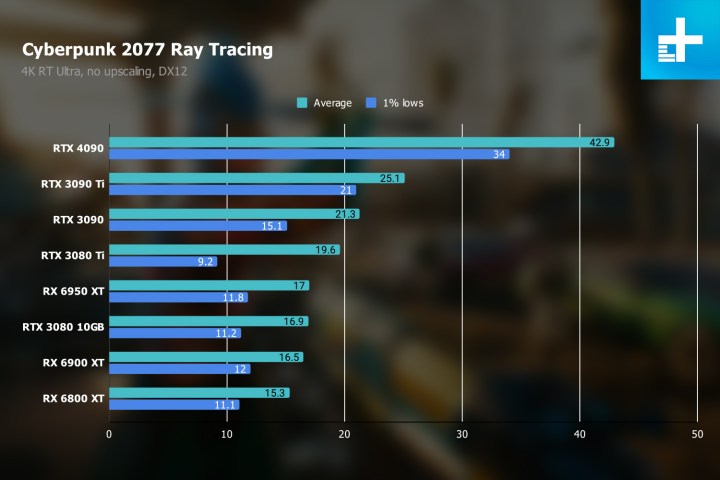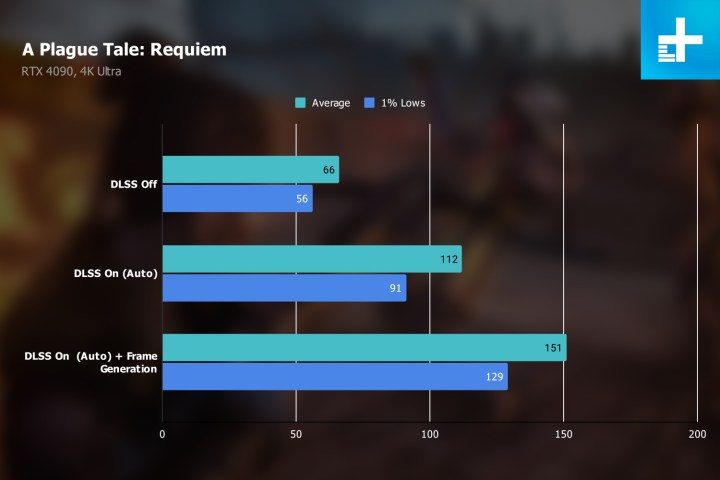The Nvidia RTX 4090 is Nvidia’s new flagship graphics card that is set to dominate high-end gaming PCs and benchmark top-10 lists for the medium turn future. Now that our RTX 4090 review is complete, however, the conversation falls to how well the RTX 4090 fares against the existing kings of the hill: the RTX 3090 and RTX 3090 Ti.
Can these now last-generation cards still hold their own, or is the RTX 4090 too dominant?
Specs
Nvidia released (almost) the full specifications for the RTX 4090 at its GTC keynote speech, debuting it alongside the RTX 4080 for the first time.
| RTX 4090 | RTX 3090 Ti | RTX 3090 | |
| Architecture | Ada Lovelace | Ampere | Ampere |
| GPU | AD102 | GA102 | GA102 |
| Process node | 5nm TSMC | 8nm Samsung | 8nm Samsung |
| CUDA cores | 16,384 | 10,752 | 10,496 |
| RT cores | 144 3rd-gen | 84 | 82 |
| Tensor cores | 576 4th-gen | 336 | 328 |
| Base clock | 2235MHz | 1560MHz | 1395Mhz |
| Boost clock | 2520MHz | 1860MHz | 1695MHz |
| Memory | 24GB GDDR6X | 24GB GDD6X | 24GB GDDR6X |
| Memory speed | 21 Gbps | 21Gbps | 19.5Gbps |
| Memory bus width | 384-bit | 384-bit | 384-bit |
| Bandwidth | 1018GBps | 1018GBps | 936GBps |
| TDP | 450W | 450W | 350W |
With this generation of GPUs, we see a big uptick in CUDA cores again, as well as additional next-generation RT and Tensor cores helping to deliver faster ray tracing and better DLSS. Clock speeds have taken a big leap too, which will help deliver the big performance gains Nvidia promised.
The added efficiency of the new architecture on its new 5nm process is what appears to have allowed Nvidia to raise core count and clock speeds so dramatically while maintaining the same power requirements as the RTX 3090 Ti. That’s still a big TDP, but it’s certainly more manageable than some of the rumored totals that were doing the rounds in recent weeks.
Memory configurations remain much the same as the RTX 3090 Ti, though they still represent a big uplift over the RTX 3090.
Pricing and release
The RTX 3090 was released in September 2020, shortly after the flagship RTX 3080. Its price was initially $1,500, but it fluctuated greatly over the past two years, rising to over $3,000 at times. At the time of writing, you can buy it for around $900 at most retailers.
The RTX 3090 Ti released in March 2022 with a debut price of $2,000. Shortages at the time meant it could hit $4,000 in some cases, but prices came crashing down shortly after, and today it can be found for as little as $1,000.
The RTX 4090 first debuted at Nvidia’s GTC keynote speech on September 20. It officially launched on October 12, with a price tag of $1,599. That’s a big drop from the 3090 Ti’s launch price, showing that Nvidia isn’t raising costs dramatically across the board, but it is lifting it from the original RTX 3090’s price and with prices rising on the RTX 4080 cards, this generation will still be more expensive than the last; significantly so in some cases.
Performance
It was always clear that the Nvidia RTX 4090 was going to be faster than the RTX 3090 and 3090 Ti. The question was just, by how much?
Nvidia didn’t go into great detail with first-party benchmarks at its GTC showcase, but we’ve had plenty of hands-on time with the new card and have put it through its paces to find just how well it stands up against the last-generation kingpins from both Nvidia and AMD.

Right out of the gate in 3DMark testing, it was clear that the RTX 4090 is a different beast entirely. The RTX 3000 and RX 6000 GPUs are almost neck and neck in Time Spy, but the RTX 4090 destroys them all. The same goes for Port Royal, where the RTX 4090 delivers actual comfortable frame rates and a corresponding score that shows how much better it is at ray tracing than any card that’s come before.

Across our range of game testing, the RTX 4090 continued to seriously outperform every other GPU we pitted it against, including the venerable flagships of just a few weeks ago. The RTX 3090 and RTX 3090 Ti are still stupendous cards, especially when it comes to 4K gaming, but the RTX 4090 blows them both out of the water.
For more per-game test results, be sure to dive into our full-length RTX 4090 review.
The above graph shows the RTX 4090 with an average frame rate greater than 50% more than the RTX 3090 Ti across our range of tested games. Most impressive was the performance bump we saw at 4K in the ever-so-demanding Cyberpunk 2077 with ray tracing enabled. There, the RTX 4090 was the only card to manage over 30 FPS 1% lows, guaranteeing a stutter-free gaming experience.

This is with DLSS disabled, so you can expect much better performance from all tested Nvidia cards with that setting enabled, but this shows the raw capabilities of the card without all the technical wizardry Nvidia has brought to bear in recent years.
Overall, the performance of the RTX 4090 is incredibly impressive, and it’s no doubt the fastest GPU ever made. However, it’s not quite the 2-4 times performance improvement that Nvidia claimed in its original briefing.
Features
Like the 3090 Ti and 3090 before it, the RTX 4090 supports both ray tracing and DLSS. Also, thanks to its greater RT and Tensor core counts and next-generation hardware, it sees a big performance bump when either or both are enabled, compared to the previous generation. Nvidia talked up its new DLSS 3 algorithm at GTC, showcasing that it can lead to a huge uplift in performance when enabled. This is an RTX 4000-series exclusive feature, so you’ll need a next-gen card to take advantage. However, DLSS3 has to be added to games specifically, so, like previous DLSS releases, its impact will be limited to start with.

The RTX 4090 can leverage DLSS 1 and DLSS 2 far better than its predecessors, too, so whether you’re playing the latest DLSS 3 games or one of the older ones with an earlier version of the upscaler, you’ll see excellent gains with the RTX 4090.
Is the RTX 4090 a waste of money?
The RTX 4090 is without doubt the fastest graphics card ever made and considering its big uplift in performance, it’s actually more cost effective on a dollar per-frame basis than the RTX 3090 and 3090 Ti, despite being significantly more expensive. However, the question remains whether you actually need all that added performance.
If you want to play games at 4K, you can absolutely do that with the RTX 3090 which you can now find for under $900. The RTX 3090 Ti is even available for around $1,000. Considering the RTX 4090 costs over 50% more and all it will let you do is play the same games at the same resolution, but at higher frame rates, it’s not necessarily an easy one to recommend.
If you have $1,600 to spend and want the best graphics card money can buy, then the RTX 4090 is it. But for just about everyone else, there’s a more cost-effective GPU you can buy.
Now all eyes turn to what AMD has planned with its upcoming RDNA 3 generation of GPUs, to see what effect that has on the top-tier performance dynamic.
Editors’ Recommendations

